
E-Mail Us:
railarchive@mail.com
Text and photo images
©2013 Richard Leonard.

Canadian Pacific Railway
Returning to the Midwest after a family vacation trip in New England in August 1955, my parents chose the northern route through Ontario by way of Ottawa, North Bay and Sault Ste. Marie. This route paralleled lines of the Canadian Pacific and allowed us to see and photograph some of its steam power, which was still very active. Our first stop was the Canadian Pacific terminal facility in Ottawa, where we found a few of the older and smaller locomotives such as Consolidations (2-8-0 type) and Ten-Wheelers (4-6-0 type) that still performed branch line, local freight and switching duties.
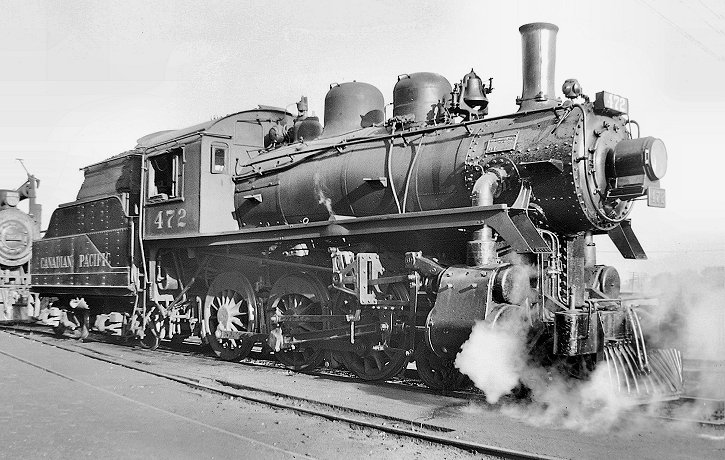
Ten-Wheeler No. 472, shown here simmering away on one of the roundhouse lead tracks, was a member of class D4g outshopped by Montreal Locomotive Works in 1914. This class had 62-inch drivers and 19x24-inch cylinders, and carried 180 pounds per square inch of boiler pressure. The locomotive weighed 66 tons without tender. Class D4g had 28 square feet of grate area, 1081 square feet of evaporative heating surface and a superheater surface of 195 square feet. The tractive effort would have been about 21,380 pounds following the usual formula. No. 472 saw service under the often-severe weather conditions of eastern Canada and northern New England; Jean-Louis Ouellette provided a photo of No. 472 snowbound on the CPR's line between Farnham and Bedford, Québec around 1938. No. 492 of this class is preserved at the Exporail, the Canadian Railway Museum in Saint-Constant/Delson, Québec, while No. 453 of this class is reportedly stored in Utica, New York with its future plans uncertain.
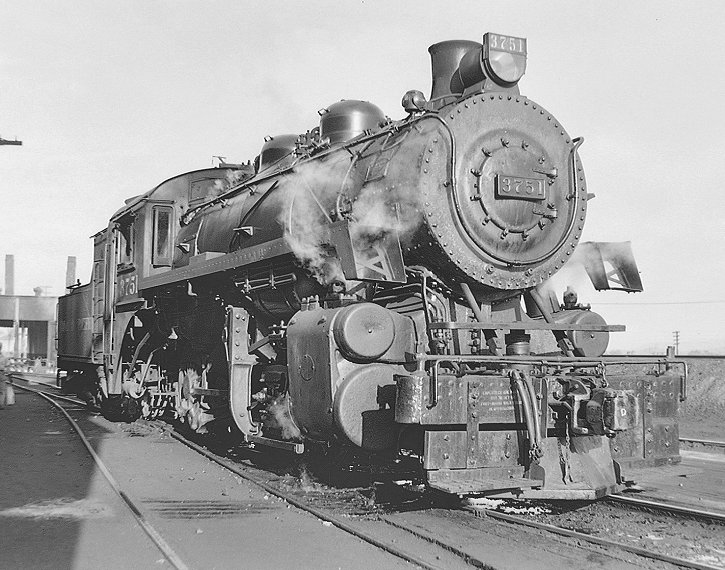
Consolidation No. 3751, of 1913-14 vintage, stood ready behind No. 472. These engines of class N2c had 63-inch drivers and 23x32-inch cylinders. They sustained 190 pounds per square inch of boiler pressure and weighed 109 tons. With 50 square feet of grate area, they had 2316 square feet of evaporative heating surface and 602 square feet of superheater surface. No. 3751 appears to be a product of the Montreal Locomotive Works, and mustered some 43,400 pounds of tractive force.
Locomotives like these occupy some of my earliest memories, for when I was between the ages of three and five my father pastored the Methodist Church in Lyndonville, Vermont, and we lived in the parsonage adjacent to the Canadian Pacific tracks. Lyndonville was a busy spot then, during the heavy-traffic days of World War II. The CPR operated a locomotive and car repair facility there, and I well recall the day that Dad took me on a visit to the shops and I was frightened by the welding torches! Motive power on this line was pooled between the Boston & Maine and the Canadian Pacific, and consisted of CPR 4-6-0s and 2-8-0s, B&M 2-8-0s, and CPR 4-6-2s on the night passenger train. I can remember the air raid drill blackouts on occasional nights during the war, when we had to lower all the window shades of our home. On the railroad, the locomotives had a special shield over their headlights to reduce their visibility to potential enemy bombers. Perhaps these two older workhorses were among them.
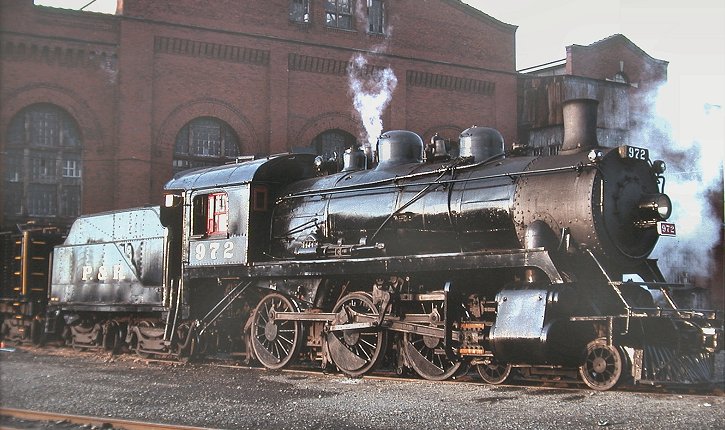
For local and branch line service, over trackage often laid with lighter rail during a period of rapid railroad expansion in Canada, the Canadian Pacific needed a smaller locomotive that could handle both passenger and freight traffic. The 4-6-0 or Ten-Wheeler type met this requirement, and the CPR rostered a large number of these engines in several classes. Most numerous of these was class D10. Between 1907 and 1913 the CPR acquired more than 500 locomotives of this class from the major Canadian builders as well as its own Angus Shops in Montreal. They had 63-inch drivers and 21x28-inch cylinders, and carried 200 pounds of boiler pressure. Weighing 93 tons, they produced about 30,000 pounds of tractive force. Some of these engines were active to the very end of steam operations, and six representatives of the D-10 class remain today. My late brother David V. Leonard took this transparency of No. 972, of class D10j, at Reading, Pennsylvania on October 9, 1983. At that time she was based in Reading and pulling excursion specials over trackage in the region. Today No. 972 is stored inoperative at the Strasburg Rail Road in Pennsylvania.
For heavy passenger service the Canadian Pacific preferred the 4-6-4 or Hudson type, of which it had 65 engines. (The Canadian National owned only five.) The famous Royal Hudsons were preceded by earlier classes built by Montreal Locomotive Works beginning in 1929. The first group, class H1a, is represented here at Chalk River, Ontario, by No. 2809. Like all newer Canadian steam locomotives and many built for railroads in the northern United States, No. 2809 had an all-weather vestibule cab providing greater protection for the engine crew during the colder seasons.
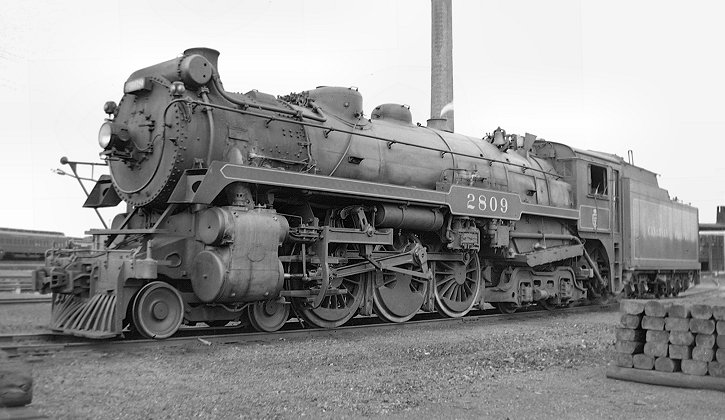
Featuring 75-inch drivers, members of the H1 class developed a tractive effort of 45,300 pounds. They had 22x30-inch cylinders and carried 275 pounds of boiler pressure. Their steaming capacity stemmed from an 81-square-foot grate area, together with an evaporative heating surface of 3791 square feet augmented with 1542 square feet of superheater surface. Sister locomotive No. 2816 of class H1b survives. Reacquired by Canadian Pacific, she was painstakingly restored to service as an oil burner and dubbed the "CPR Empress." a public relations vehicle for the railroad. Sadly, with a change in CPR management that program was suspended.
As we prepared to leave the Ottawa terminal the Canadian Pacific surprised us with an unexpected bonus, the arrival of Royal Hudson No. 2822 on an eastbound passenger train. These 4-6-4 type locomotives, semi-streamlined with a recessed headlight and trimmed in black, silver and deep red, received the name "Royal Hudson" after one of them (No. 2850) pulled the train of Britain's monarchs George VI and Elizabeth during their 1939 visit to the Dominion of Canada. (Notice the embossed gold crown on the side of the running board skirt, over the cylinder.)
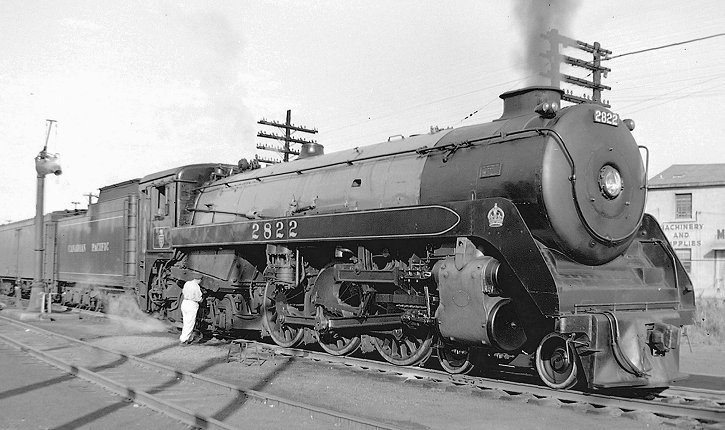
Delivered in several groups by Montreal Locomotive Works, the Royal Hudsons had 75-inch drivers, 22x30-inch cylinders, a boiler pressure of 275 pounds per square inch, and a locomotive weight of 366,000 pounds. They exerted 45,300 pounds of tractive effort (57,330 with booster engine operating). With a grate area of 81 square feet, these "Royal Hudsons" had an evaporative heating surface totaling 3791 square feet and a superheating surface of 1542 square feet. No. 2822 belonged to class H1c, the first group of Royal Hudsons, and was delivered in 1937. According to the information provided by Don's Depot (Don's Rail Photos), she was retired at the end of 1959. Four of the Royal Hudsons are preserved in Canada and the United States, two of which have been operational at different times.
The diesel era, dominated by the products of General Motors' Electro-Motive Division, brought a measure of uniformity to the motive power fleets of North American railroads. In the days of steam, however, each railroad pursued its own distinctive motive power policy. The contrast between the two Canadian transcontinentals, Canadian National and Canadian Pacific, is a case in point. Traversing the same geographic region under the same conditions, the two railroads nevertheless rostered a different configuration of steam power.
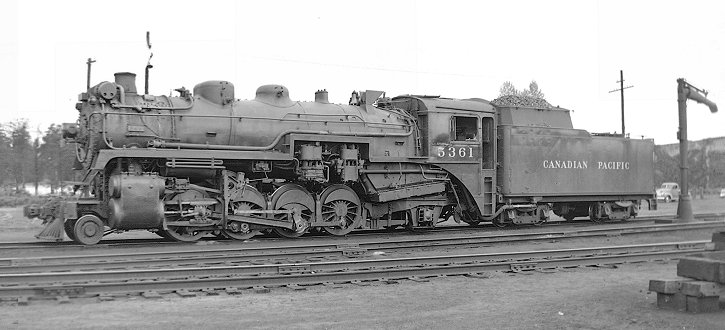
The locomotive preferences of the Canadian Pacific were displayed for us as we pursued our way westward and arrived at the locomotive servicing facility in Chalk River, Ontario. Here we found 2-8-2 No. 5361, pictured here, resting between assignments. Whereas the Canadian National favored the 4-8-4 as a dual-service locomotive, operating more than any other railroad, the Canadian Pacific continued to use the 2-8-2 in heavy main line freight service and even received an order of new ones as late as 1944.
A member of class P2e, No. 5361 was built in 1926 by the Canadian Locomotive Company. Her 63-inch drivers were powered by 23x32-inch cylinders at 250 pounds of boiler pressure. The grate area of class P2e measured 84 square feet, the evaporative heating surface 3436 square feet, and the superheater surface 970 square feet. These locomotives weighed 306,000 pounds and exerted 57,100 pounds of tractive force. No. 5631 has been preserved at an industrial park in Depew, New York, facing an uncertain future.
The Canadian Pacific owned more than 400 Pacific or 4-6-2 type locomotives, and like most major North American railroads it used them in passenger service. But few railroads used them also in freight service to the same extent as the CPR. A handful of 4-6-2s served local freight assignments until the early 1960s, probably the last steam engines operated by the Canadian Pacific.
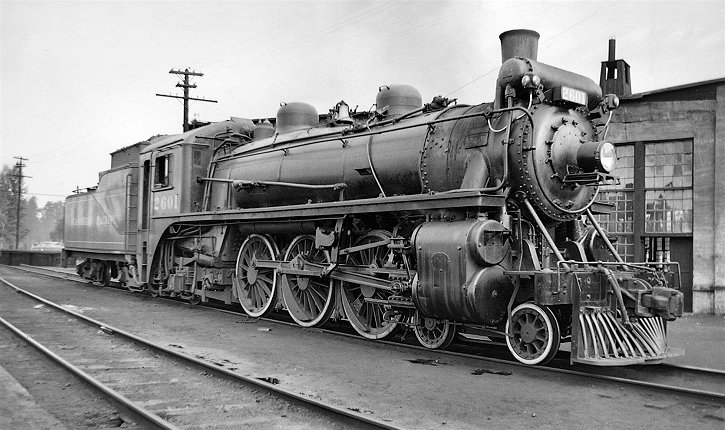
At Chalk River, Ontario, in August 1955 we found G2s Pacific No. 2601 on standby adjacent to the roundhouse. These Pacifics were built by Montreal Locomotive Works in 1911, and had 70-inch drivers and 20x28-inch cylinders. Ahead of her unusually tall stack No. 2601 sports an Elesco feedwater heater, giving her a proud and dignified look. It was not original equipment but was applied during a 1922 rebuild, during which her cylinders were modified a to the dimensions given and she was reclassified from class G2d.
The purpose of the feedwater heater was to use exhaust steam from the cylinders to preheat fresh water going into the boiler. Most North American steam locomotives built, or rebuilt, after about 1920 were equipped with feedwater heaters. Several common types were in use: the Elesco, the Worthington (either side-mounted or in the smokebox) and the Coffin. No. 2601 was scrapped a year after this photo was taken, but sister 2634 is displayed in Moose Jaw, Saskatchewan.
Canadian Pacific's 4-6-2 No. 2317 was constructed by Montreal Locomotive Works in 1923, and handled main line freight and passenger trains until being retired in 1959. In 1965 the late F. Nelson Blount bought the locomotive; she was restored to service in 1978 at Steamtown's Bellows Falls, Vermont location. Steamtown's move to Pennsylvania in 1984 brought No. 2317 to Scranton. The National Park Service acquired the bankrupt Steamtown's assets in 1986, and in recent years No. 2317, together with former Canadian National 2-8-2 No. 3254, have been mainstays of the Steamtown operation. (Both are currently out of service.) I photographed her digitally at Scranton on July 26, 2005.
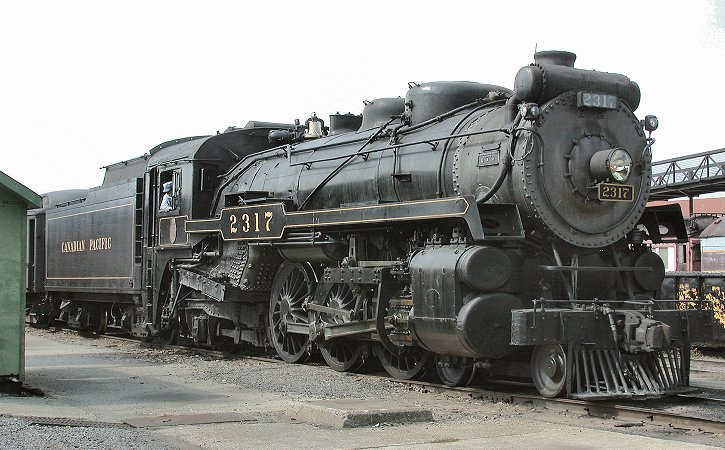
A representative of CPR's G3c class, No. 2317 has 75-inch drivers and 25x30-inch cylinders, and sustains 200 pounds per square inch of boiler pressure. With a grate area of 65 square feet, she has 3530 square feet of evaporative heating surface and 803 square feet of superheater surface, and weighs 319,000 pounds.
The Canadian Pacific was so fond of the Pacific type that it acquired new 4-6-2s as late as 1948, ordering them from Canadian builders or constructing them at its own large Angus Shops complex in Montreal. The locomotives of class G5 were intended for light freight duty across Canada, and the G5d subclass of this modest design was the last group to be placed in service after manufacture by Canadian Locomotive Company in 1948. The G5s had 20x28-inch cylinders and 70-inch diameter drivers. These specifications, together with an engine weight of 229,500 pounds and a boiler pressure of 250 pounds per square inch, gave them a tractive effort of 34,000 pounds. They had a grate area of 46 square feet, an evaporative heating surface of 2576 square feet, and a superheating surface of 744 square feet..
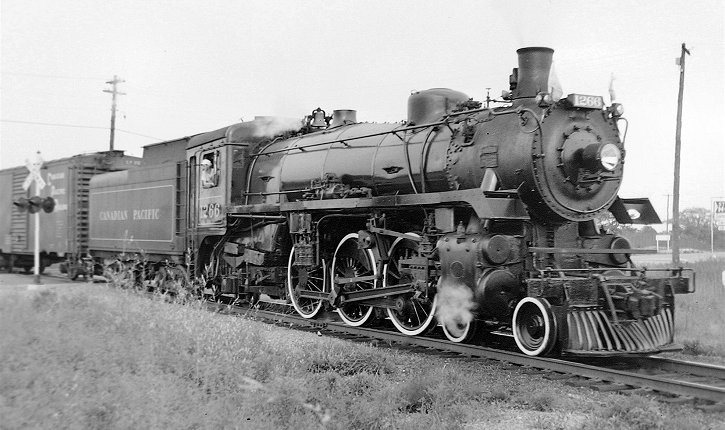
At Sturgeon Bay, Ontario, in August 1955 we found the nicely trimmed and shining No. 1266, a representative of subclass G5c built by the Canadian Locomotive Company in 1947, performing switching duties. In the photograph, the engineer's posture and the position of the valve gear betray the fact that the engine is moving in reverse, backing boxcars onto a siding.
Although No. 1266 was scrapped in 1962, six of the G5s are extant. The best known is probably No. 1293 of subclass G5d, outshopped in 1948 by the Canadian Locomotive Company. She was acquired in 1963 by F. Nelson Blount, eventually passing to the Steamtown Foundation, and after was owned by the late Jerry Jacobson. Operated for a time on his Ohio Central Railroad, she is now at the Age of Steam Roundhouse near Sugarcreek, Ohio.
No. 1246 of class G5c, erected in 1946 by Montreal Locomotive Works, was also acquired by F. Nelson Blount for his New Hampshire operation and then ran in Vermont on his Green Mountain Railroad over former Rutland Railroad trackage between Bellows Falls and Rutland. The transparency below was captured by my father, Dr. R. D. Leonard, in the fall of 1970 at Rutland. Note that the locomotive has been named "F. Nelson Blount" in honor of Steamtown's founder, who lost his life in a plane crash in 1967. Today No. 1246 is displayed at the Railroad Museum of New England in Thomaston, Connecticut.
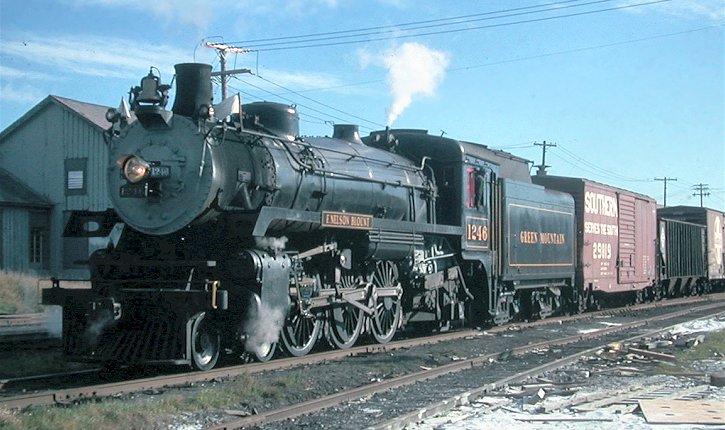
No. 1278 of the same class achieved notoriety while being operated in tourist service on the Gettysburg Railroad in Pennsylvania in June 1995. Due to low water level the crown sheet (above the firebox) failed and three crewmen were seriously injured by escaping steam. If the water level is not maintained over the crown sheet it can warp and rupture. The water in the boiler is under pressure (in this case up to 250 pounds per square inch) which prevents it from becoming steam until well above the normal boiling point. When a rupture occurs the pressure is released, and the water flashes to steam in an "explosion." In most locomotives this would have resulted in destruction of the locomotive and death of the crew, but No. 1278 had been built in Canada with an extra array of staybolts that prevented the crown sheet from being completely torn apart. The U.S. Transportation Safety Board determined that a scale blockage in the water level gage and a leaking check valve between the water feed pump and the boiler were among the factors contributing to the incident, and mandated more stringent safety practices and improvements in operating steam locomotives as a result. Today No. 1278 is also at the Age of Steam Roundhouse and will likely never be restored to operation, being preserved as an exhibit of the hazard involved in slipshod maintenance of steam equipment.
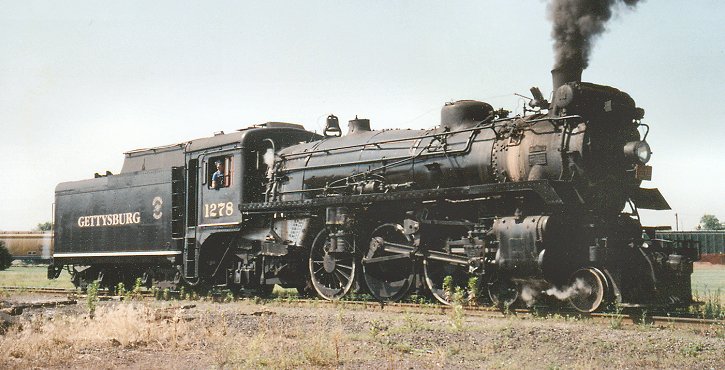
I photographed No. 1278 in her happier days of service with the Gettysburg tourist operation, during a trip through Pennsylvania in June of 1993. Of this locomotive class, the former Ohio Central web site commented: "Although they were among the last steam locomotives purchased by the Canadian Pacific, the class G5 bore more than a passing resemblance to other CP 4-6-2s built as early as 1905. Combining the reliability of an old and proven design with the efficiency of latter day steam technology, the G5s were instantly successful, and found favor over virtually all of the CP system."
According to Wes Barris' Surviving Steam Locomotives site, about fifty former Canadian Pacific steam locomotives still exist and a dozen are operable. This must be one of the highest percentages of preserved steam power among North American railroads. However, I am glad I had the chance to see and photograph CPR steam in revenue service, in the waning summer days of 1955. For some alternate views of the same locomotives I photographed then, visit the Canada Collection in our Random Steam Photo Collection.
